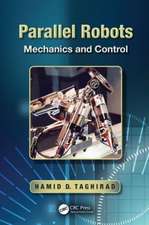Microsurgery: Advances, Simulations and Applications
Editat de Toshio Fukuda, Carlos Terceroen Limba Engleză Hardback – 24 apr 2012
Preț: 1107.14 lei
Preț vechi: 1383.92 lei
-20% Nou
Puncte Express: 1661
Preț estimativ în valută:
211.88€ • 220.39$ • 174.92£
211.88€ • 220.39$ • 174.92£
Carte tipărită la comandă
Livrare economică 14-28 aprilie
Preluare comenzi: 021 569.72.76
Specificații
ISBN-13: 9789814364690
ISBN-10: 981436469X
Pagini: 336
Ilustrații: 231 b/w images and 15 color images
Dimensiuni: 152 x 229 x 23 mm
Greutate: 0.59 kg
Ediția:1
Editura: Jenny Stanford Publishing
Colecția Jenny Stanford Publishing
ISBN-10: 981436469X
Pagini: 336
Ilustrații: 231 b/w images and 15 color images
Dimensiuni: 152 x 229 x 23 mm
Greutate: 0.59 kg
Ediția:1
Editura: Jenny Stanford Publishing
Colecția Jenny Stanford Publishing
Public țintă
Academic and PostgraduateCuprins
Introduction. Endovascular Treatmetns for Neurology. Patient-Specific Vascular Modeling. Respect for Tissue Representation Using Photoelastic Stress Analysis for Endovascular Surgery Simulation. Numerical Simulation for Blood flow. Pumps for Human Blood Pressure Simulation. Magnetic Trackers: Robot Control and Vasculature Imaging. Tailor-Made and Biodegragable Vasculature Scaffolds.
Recenzii
"This book presents an important and timely subject and collects a wide range of knowledge derived from the contributors’ vast experience. It is the first to integrate medicine and engineering exceptionally well. It is a great text for graduate-level students, researchers, and doctors specializing in microsurgery."
—Prof. Tzyh Jong Tarn - Washington University in St. Louis, USA
—Prof. Tzyh Jong Tarn - Washington University in St. Louis, USA
Notă biografică
Toshio Fukuda received his bachelor’s degree from Waseda University, Tokyo, Japan, in 1971, and master’s and Dr.Eng. from the University of Tokyo, Japan, in 1973 and 1977, respectively. In 1977, he joined the National Mechanical Engineering Laboratory. He joined the Science University of Tokyo, Japan, in 1982 and Nagoya University, Nagoya, Japan, in 1989. Currently, he is director of Center for Micro‐Nano Mechatronics and professor at Department of Micro‐Nano Systems Engineering at Nagoya University, where he is mainly involved in the research fields of intelligent robotic and mechatronic system, cellular robotic system, and micro‐ and nano‐robotic system. He has been Distinguished Professor, Seoul National University, since 2009.
Carlos Tercero received his bachelor’s and Licenciature degrees from the Department of Electronics Engineering at Del Valle de Guatemala University, Guatemala, in 2002 and 2003. He received his M.S. degree from the Complex System Science Department of Nagoya University, Japan, in 2007, and Dr.Eng. degree from the Micro‐Nano Systems Engineering Department of Nagoya University, in 2008. In 2008, he was the director of the Electronics and Mechatronics Engineering Departments at Del Valle de Guatemala University. Since April 2009, he has been with the Global Center of Excellence for Education and Research of Micro‐Nano Mechatronics of Nagoya University, where he is mainly involved in the research fields of medical robotics and in vitro simulation for endovascular intervention. He is the recipient of the Society of Instrument and Control Engineers Technical Field Award (2010) and the International Symposium on Micro‐Nano Mechatronics and Human Science Best Paper Award (2010) and also IEEE/RSJ International Conference on Robots and Systems ICROS Best Application Paper Award finalist (2010).
Carlos Tercero received his bachelor’s and Licenciature degrees from the Department of Electronics Engineering at Del Valle de Guatemala University, Guatemala, in 2002 and 2003. He received his M.S. degree from the Complex System Science Department of Nagoya University, Japan, in 2007, and Dr.Eng. degree from the Micro‐Nano Systems Engineering Department of Nagoya University, in 2008. In 2008, he was the director of the Electronics and Mechatronics Engineering Departments at Del Valle de Guatemala University. Since April 2009, he has been with the Global Center of Excellence for Education and Research of Micro‐Nano Mechatronics of Nagoya University, where he is mainly involved in the research fields of medical robotics and in vitro simulation for endovascular intervention. He is the recipient of the Society of Instrument and Control Engineers Technical Field Award (2010) and the International Symposium on Micro‐Nano Mechatronics and Human Science Best Paper Award (2010) and also IEEE/RSJ International Conference on Robots and Systems ICROS Best Application Paper Award finalist (2010).
Descriere
This book explains, using the example of endovascular intervention, the development of in vitro simulators for biomedical applications based on the scientific context in the robotics area and the explanation of the medical procedure to be simulated. It presents modeling methods for in vitro representation of human tissue and for representing tissue integrity during endovascular surgery simulation. Additionally, applications of this in vitro vasculature modeling technology are presented: flow control for human blood pressure simulation, computer fluid dynamics simulations using vasculature morphology, catheter insertion robot control and vasculature imaging based on magnetic trackers, and tailor-made scaffolds for blood vessel regeneration.










